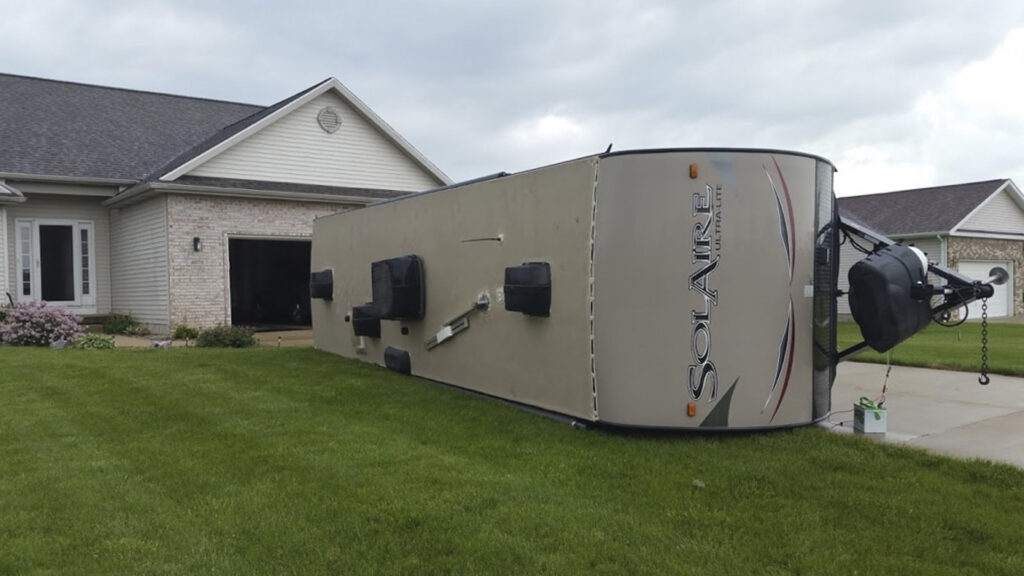
How Much Wind Can a Travel Trailer Withstand Parked?
Table of contents
For RV and travel trailer owners, understanding the impact of wind resistance is essential. High winds pose a significant risk to parked trailers, leading to concerns about safety, stability, and potential damage. Wind gusts can cause swaying, destabilize your RV, or even push it off balance, increasing the risk of tipping. Questions like “how much wind can a travel trailer withstand parked?”, “how much wind can an RV withstand?”, or “can a camper tip over when parked?” are common among RV enthusiasts, especially during stormy weather. This guide addresses these questions and provides practical tips to ensure your travel trailer, camper, or fifth wheel remains safe in high wind conditions. By understanding your RV’s wind tolerance and implementing the right safety measures, you can avoid costly repairs, preserve the longevity of your RV, and enjoy peace of mind while on the road or parked at a campsite.
Understanding Wind Resistance in Travel Trailers

Factors Affecting a Travel Trailer’s Wind Resistance
Several factors influence how much wind can a fifth wheel withstand parked:
- Size and Weight
Heavier and more compact trailers generally have better wind resistance due to their lower center of gravity. Lightweight campers, while easier to tow, are more susceptible to tipping. - Shape and Aerodynamics
Rounded edges and streamlined designs reduce wind resistance, while flat surfaces act as sails, making trailers more vulnerable to strong gusts. - Construction Materials
High-quality materials, such as reinforced fiberglass or aluminum, can withstand wind forces better than older or less durable materials. - Stabilization Features
Built-in stabilizers, jacks, and tie-down points improve a trailer’s ability to remain steady during high winds.
Wind Speed Thresholds for Travel Trailers
The exact wind speed a trailer can withstand, or how much wind a camper can withstand, varies depending on its size, weight, and stabilization methods. However, general guidelines suggest:
- 20-30 mph winds: Typically manageable, but gusts may cause minor sway.
- 30-50 mph winds: Begin taking precautions as these speeds can destabilize lighter trailers.
- 50+ mph winds: Dangerous for most parked trailers, especially if not properly stabilized or anchored.
Manufacturers often provide wind resistance data, so check your trailer’s manual for specific thresholds. Remember, how much wind can a fifth wheel withstand parked may differ from a smaller camper due to its design and weight distribution.
Preparing Your Travel Trailer for High Winds

Proper Positioning and Orientation
Positioning your trailer correctly can significantly reduce wind impact:
- Face the Nose into the Wind: This reduces the surface area exposed to gusts, improving stability.
- Use Natural Windbreaks: Park near trees, hills, or buildings to shield your trailer from strong winds.
- Avoid Open Spaces: Campgrounds with wide, open areas offer little protection against gusts.
Each of these strategies can make a difference in how much wind a camper can withstand.
Stabilization Techniques
Stabilizing your travel trailer minimizes sway and prevents tipping:
- Wheel Chocks: Secure the wheels to prevent rolling.
- Stabilizing Jacks: Lower these to provide additional support.
- Hydraulic Jacks: Ideal for leveling and adding stability during high winds.
These measures improve safety and can be particularly helpful when addressing concerns about “can a camper tip over when parked?”
Additional Anchoring Methods
In areas prone to high winds, additional anchoring methods may be necessary:
- Mobile Home Tie-Downs: Use heavy-duty straps to anchor the trailer to the ground.
- Weighted Anchors: Place weights on the stabilizer arms for added resistance.
- Cables and Chains: Secure the trailer to fixed structures like concrete anchors or steel posts.
These advanced techniques enhance your trailer’s ability to stay put in strong winds.
Monitoring Wind Conditions
Weather Forecasting and Apps
Reliable weather tools are essential for RV owners to stay informed and ensure the safety of their trailers during high winds.
- AccuWeather and Windy: These popular apps provide detailed wind forecasts, real-time updates, and wind speed alerts, which can help you assess how much wind your RV can withstand in your area. They also offer interactive maps that show wind patterns, allowing you to plan and reposition your RV if necessary.
- NOAA Weather Radio: This reliable tool offers real-time updates on weather conditions and emergency warnings, including wind advisories. NOAA broadcasts are especially helpful in areas where cellular signals might be weak, ensuring you stay informed no matter where you’re parked.
- RV-Specific Apps: Several apps, such as RV Life and RV Parks & Campgrounds, provide customized weather forecasts for campers and trailers. These apps often offer wind-specific data, which is particularly useful for understanding how much wind a travel trailer, fifth wheel, or camper can withstand parked, and they help you plan accordingly.
Regularly checking these tools will help you stay ahead of potential weather threats and understand the limits of your RV’s wind tolerance in your location, helping you maintain a safe and secure camping experience.
On-Site Wind Monitoring
Real-time wind monitoring helps you stay ahead of sudden changes:
- Portable Weather Stations: Devices like the Kestrel Weather Meter provide accurate on-site readings.
- Wind Meters: Simple handheld tools measure wind speeds directly at your campsite.
Monitoring conditions on-site ensures you’re prepared for any high wind events.
Safety Measures During High Wind Events
When to Take Action
When wind speeds approach 30-40 mph, start implementing safety measures:
- Secure all loose items around the trailer.
- Double-check stabilizers and anchors.
- Avoid staying inside the trailer if gusts exceed 50 mph, as tipping becomes a risk.
Being proactive can prevent accidents and reduce anxiety about “how much wind can a travel trailer withstand parked?”
Emergency Procedures
If winds become dangerously strong:
- Relocate if Possible: Move to a sheltered area or reposition the trailer.
- Seek Alternative Shelter: Stay in a sturdy building if winds exceed safe limits for your camper.
- Turn Off Utilities: Disconnect propane and electricity to prevent potential hazards.
These steps are critical for safety during extreme weather, especially when considering how much wind a fifth wheel can withstand parked.
Maintenance and Upgrades for Wind Resistance

Regular maintenance and thoughtful upgrades improve a trailer’s ability to withstand high winds:
- Inspect Seals and Fasteners: Ensure windows, doors, and roof seals are intact to prevent wind damage.
- Reinforce Vulnerable Areas: Add braces to support weak points in the frame or walls.
- Upgrade to Wind-Resistant Skirting: Reduces undercarriage exposure to wind and enhances stability.
These upgrades help mitigate risks and boost confidence in handling high winds.
Understanding how much wind a travel trailer can withstand parked is essential for ensuring safety and peace of mind. Factors like size, weight, and stabilization all play a role in determining wind resistance. By positioning your trailer strategically, using proper anchoring methods, and monitoring wind conditions, you can minimize risks. Regular maintenance and upgrades further enhance your trailer’s stability, so you can confidently answer questions like “can a camper tip over when parked?”
Prepare now to protect your travel trailer, fifth wheel, or camper and enjoy your adventures worry-free—even when the wind picks up.
Enhance Your Trailer’s Wind Resistance with Custom RV Skirting
Worried about how much wind your travel trailer can withstand parked? Protect your RV with custom skirting, which not only helps stabilize your vehicle against strong winds but also provides insulation for year-round comfort. Our #1 RV Skirting Solution is tailored to fit your trailer perfectly, with our “No-Snap, No-Gap” system keeping out water, snow, and wind. With over a decade of proven performance in harsh weather, you can trust our skirting to secure your RV and ensure a smooth adventure, no matter the conditions. Get custom skirting today and take control of your RV’s wind resistance and comfort!
